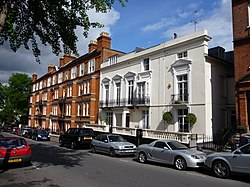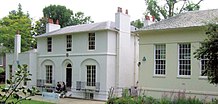Hampstead
| Hampstead | |
| Middlesex | |
|---|---|
 Downshire Hill | |
| Location | |
| Grid reference: | TQ265855 |
| Location: | 51°33’15"N, 0°10’28"W |
| Data | |
| Post town: | London |
| Postcode: | NW3 |
| Dialling code: | 020 |
| Local Government | |
| Council: | Camden |
| Parliamentary constituency: |
Hampstead and Kilburn |
Hampstead is wealthy town set below Hampstead Heath in Middlesex. Its name derives from the Old English Hamstede meaning "homestead", which well represents its comfy, prosperous residential character. It is in the Ossulstone Hundred of Middlesex.
Hampstead Heath is a verdant hill serving as a public open space. There are fine views over London from here. A string of ponds on either side of the Heath are the twin sources of the River Fleet, no longer the fine river it once was, now its lower reached are culverted and drawn off for flushing the drains.
Hampstead is known for its intellectual, liberal, artistic, musical, and literary associations. It has some of the most expensive housing in Middlesex: Hampstead has more millionaires within its boundaries than any other area of the United Kingdom.[1] The average price of a property in Hampstead was £1.5 million in 2018.
Hampstead Garden Suburb
- Main article: Hampstead Garden Suburb
Hampstead Garden Suburb was an early outgrowth of the "Garden City" movement which began at the turn of the nineteenth and twentieth centuries. The Suburb was created in 1906 and laid out around a central square, called Central Square, with an attempt to created a mixed character town incorporating gardens and woodland.
History
To 1900


's painting Work (1865)]]

Early records of Hampstead can be found in a grant by King Ethelred the Unready to the monastery of St. Peter's at Westminster (AD 986), and it is referred to in the Domesday Book (1086)[2]
The growth of Hampstead is generally traced back to the 17th century. Trustees of the Well started advertising the medicinal qualities of the chalybeate waters (water impregnated with iron) in 1700. Although Hampstead Wells was initially most successful and fashionable, its popularity declined in the 1800s due to competition with other fashionable spas. The spa was demolished in 1882, although a water fountain was left behind.
Hampstead started to expand following the opening of the North London Railway in the 1860s (now part of the London Overground routes), and expanded further after the Charing Cross, Euston & Hampstead Railway opened in 1907 (now part of London Underground's Northern Line) and provided fast travel to London.
Much luxurious housing was created during the 1870s and 1880s, in the area that is now the political ward of Frognal & Fitzjohns. Much of this housing remains to this day.
20th century
In the 20th century, a number of notable buildings were created including:
- Hampstead Underground station (1907), the deepest station on the Underground network
- Isokon building (1932)
- Hillfield Court (1932)
- 2 Willow Road (1938)
- Swiss Cottage Central Library (1964)
- Royal Free Hospital (mid-1970s)

Cultural attractions in the area include the Freud Museum, Keats House, Kenwood House, Fenton House, the Isokon building, Burgh House (which also houses Hampstead Museum), and the Camden Arts Centre. The large, Victorian Hampstead Town Hall was recently converted and extended as an arts centre.[3]
On 14 August 1975 Hampstead entered the UK Weather Records with the Highest 155-min total rainfall at 169 mm. As of November 2008 this record remains.
 |
 |
 |
 |
 |
Local newspapers
- Hampstead and Highgate Express[4]—known locally as the "Ham and High"
- Camden New Journal
- Hampstead Village Voice – a satirical magazine
The area is also home to the left-wing Labour magazine Tribune and the satirical magazine.
Outside links
| ("Wikimedia Commons" has material about Hampstead) |
- Hampstead and Marylebone by G. E. Mitton at Project Gutenberg
- The Heath and Hampstead Society
References
- ↑ Wade, David, "Whatever happened to Hampstead Man?". The Daily Telegraph, 8 May 2004
- ↑ Hampstead in the Domesday Book
- ↑ "London's Town Halls". Historic England. p. 32. http://research.historicengland.org.uk/redirect.aspx?id=7096%7CLONDON%27S%20TOWN%20HALLS.
- ↑ "Home - Hampstead Highgate Express". Hamhigh.co.uk. http://www.hamhigh.co.uk/.
